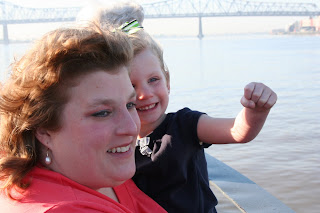
St. Jackson's Cathedral in the heart of the French Quarter
The new Pipe Organ that was just installed after Hurricane Katrina
Ceiling al frescoes
Madelyn and Mommy
Site of the 1814 Battle of New Orleans, where Andrew Jackson became a war hero and later President of the US.

Domino Sugar Refinery. You can smell the sweet sugary scent from a distance. Look close at the shovel, thats processed white sugar being unload from flat bed boats that brings the sugar up the river from nearby plantations.

Domino Sugar Refinery. You can smell the sweet sugary scent from a distance. Look close at the shovel, thats processed white sugar being unload from flat bed boats that brings the sugar up the river from nearby plantations.
All giggles and smiles about being on the boat
Sun bathing beauty
Michael taking in the scenery-- it hot got two hours later
The only naval base that is spilt in two iun the US by the MS River

Ninth Ward Levy-- you can tell from the lighter color gravel where the Corp of Engineers has filled in the breech.

Ninth Ward Levy-- you can tell from the lighter color gravel where the Corp of Engineers has filled in the breech.

On the ferry crossing the Mississippi River

The large vault is for the local order of Catholic priest


Louisiana state law states that a tomb can not be open for one year and one day from the burial of the last occupant. When the tomb is needed again, then vault is opened and the remains are then swept into a burlap bag and left in the back of the vault.

If your vault is not available due to prior occupants use, you can temporarily rent these small brick oven like vaults, until your family vault is ready. The body is placed in the chambers and because the vaults are above ground due to a high water table, the chambers acts like a slow cook oven reaching daily temperatures of 160 degrees, speeds up the decaying process of the remains.
By day, by boat, and by night we saw most of New Orleans in one day. We started out very early on a the ferry to catch a bus tour of the city to ensure we hit all the major highlights including the numerous cemeteries scattered about the city. I loved seeing how different controlling countries (French, Spanish, and US) through out the history of New Orleans left their mark either architecturally, linguistically, or ethnically upon the city. The blending of food, music and building of old and new made for a great day of sight seeing and an even bigger appreciation for the early settlers who turned the bayou into the Crescent City. It was my first trip to the Big Easy, and although I did not see the city prior to Hurricane Katrina, I am still amazed how much damage the city endure from this massive surge from Mother Nature. You can tell the city is making a valiant effort in cleaning up and rebuilding the city, but the large areas of dissolute destruction remain everywhere. There will beautiful building and homes rebuilt or renovated and then in the middle, are areas dilapidated homes and piles of debris that floated to its remaining position. Whole sections of towns wiped down to nothing but fields of concrete slabs and then civilization again. What remained was charming, intriguing and thoroughly Southern. We ended the city tour with lunch in the French Quarter before we board the Natchez Queen for an afternoon paddle boat tour of the Mighty Mississippi. And to top off the evening we had dinner at a nice restaurant in the French Quarter before embarking upon a Ghost and Cemetery tour.







































No comments:
Post a Comment